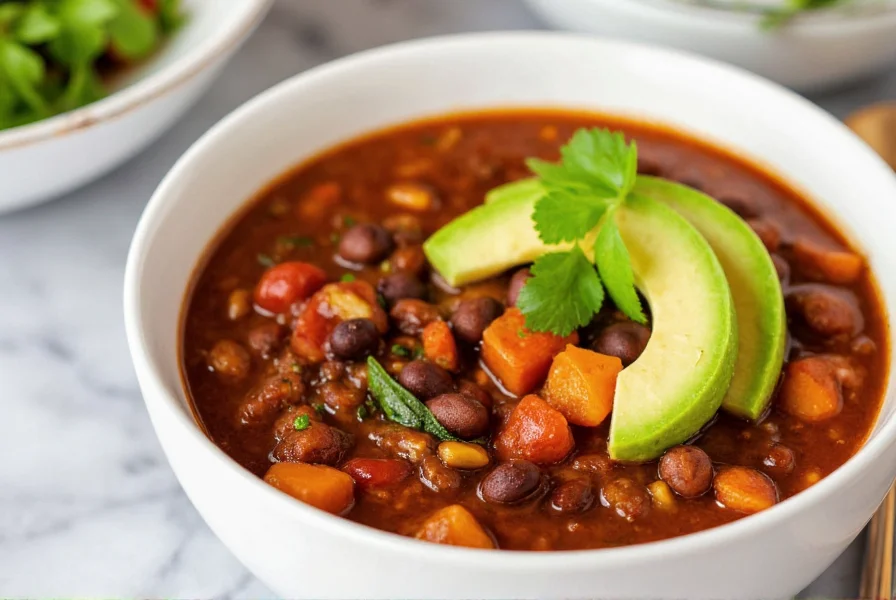Among the most popular vegetarian chili recipes on the internet, Cookie and Kate's black bean sweet potato chili stands out for its thoughtful ingredient balance and approachable preparation. Created by Kate Taylor, this recipe has gained widespread recognition for transforming traditional chili into a nutritionally complete plant-based meal without sacrificing depth of flavor or satisfying texture.
What makes this southwestern style vegetarian chili exceptional is its strategic layering of ingredients. The combination of three bean varieties—black beans, kidney beans, and pinto beans—provides complete protein while creating varied textures that prevent the "mushy" problem common in many vegetarian chili recipes. Roasted sweet potatoes add natural sweetness that balances the acidity of fire-roasted tomatoes, while toasted cumin and smoked paprika deliver authentic southwestern depth without relying on meat products.

Core Recipe Components Analysis
Understanding the purpose of each ingredient reveals why this recipe works so well. Unlike many vegetarian chili recipes that simply omit meat, this formula was designed from the ground up as a complete plant-based meal:
| Key Ingredient | Functional Purpose | Substitution Options |
|---|---|---|
| Sweet potatoes (cubed) | Adds natural sweetness, thickens broth, provides vitamin A | Butternut squash, carrots |
| Fire-roasted tomatoes | Creates complex flavor base with caramelized notes | Regular diced tomatoes + 1/2 tsp liquid smoke |
| Three bean varieties | Provides complete protein profile and varied textures | Chickpeas, lentils, or additional black beans |
| Avocado oil | High smoke point for proper vegetable sautéing | Olive oil, vegetable broth (for oil-free) |
Critical Technique Insights
The cooking process contains several technique elements that separate this from ordinary vegetarian chili recipes. Most notably, the recipe instructs to roast the sweet potatoes separately before adding to the chili. This crucial step prevents the potatoes from breaking down completely during simmering, maintaining distinct texture throughout the finished dish.
Another professional technique involves "blooming" the spices in the oil before adding liquid ingredients. This process, which many home cooks skip, transforms dried spices from dusty powders into aromatic flavor compounds that properly integrate with the other ingredients. The recipe specifically calls for toasting cumin, chili powder, and smoked paprika for 1 minute before adding tomatoes—a small step that makes a significant flavor difference.
Nutritional Advantages
This plant-based chili delivers impressive nutritional benefits that extend beyond typical comfort food. Each serving provides:
- 15g plant-based protein from the strategic combination of beans and quinoa
- 11g of dietary fiber supporting digestive health
- Over 200% of daily vitamin A from sweet potatoes
- No added sugars despite the natural sweetness
- Gluten-free and easily adaptable to oil-free preparation
The recipe's nutritional completeness comes from intentional ingredient pairing. The vitamin C from tomatoes enhances iron absorption from the beans, while the healthy fats from avocado oil improve absorption of fat-soluble vitamins from the vegetables. This represents thoughtful recipe development rather than simply removing animal products from a traditional chili formula.
Practical Recipe Adaptations
One reason for this recipe's widespread popularity is its adaptability to various dietary needs and kitchen constraints. For those following specific dietary protocols:
- For oil-free preparation: Substitute 1/4 cup vegetable broth for the oil when sautéing vegetables
- For Instant Pot cooking: Use sauté function for vegetables, then cook on high pressure for 10 minutes with natural release
- For increased protein: Stir in 1/2 cup cooked quinoa during the final simmer
- For nightshade sensitivity: Replace tomatoes with roasted beets and use annatto instead of paprika
Meal preppers appreciate how this southwestern style vegetarian chili improves after refrigeration. The flavors deepen significantly when stored, making it an excellent make-ahead option. For best results, prepare the chili one day in advance and reheat gently on the stove with a splash of water to restore ideal consistency.

Serving Recommendations
While delicious on its own, this easy weeknight vegetarian dinner recipe shines when paired thoughtfully. Traditional chili toppings work well, but these specific combinations elevate the dish:
- Fresh avocado slices with lime juice (enhances fat-soluble vitamin absorption)
- Cilantro-lime crema (Greek yogurt blended with lime zest and cilantro)
- Quick-pickled red onions (adds brightness to balance richness)
- Crumbled queso fresco or vegan cashew cheese
For complete meal planning, serve with a simple green salad featuring a citrus vinaigrette to complement the southwestern flavors. The acidity cuts through the chili's richness while adding additional vegetable variety to the meal.
Storage and Freezing Guidelines
This high protein vegetarian chili excels as a freezer-friendly option. Follow these storage recommendations for best results:
- Refrigerate in airtight containers for up to 5 days
- Freeze in portion-sized containers for up to 3 months
- Thaw overnight in refrigerator before reheating
- Reheat on stove with 2-3 tablespoons water per serving
- Avoid microwave reheating which can create uneven texture
Notably, the flavor profile improves after freezing and thawing, making this an ideal candidate for batch cooking. Many home cooks report the chili tastes even better after being frozen, as the flavors continue to meld during storage.











 浙公网安备
33010002000092号
浙公网安备
33010002000092号 浙B2-20120091-4
浙B2-20120091-4